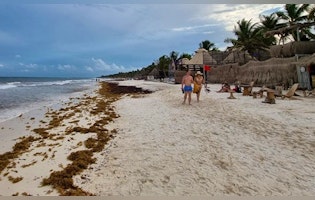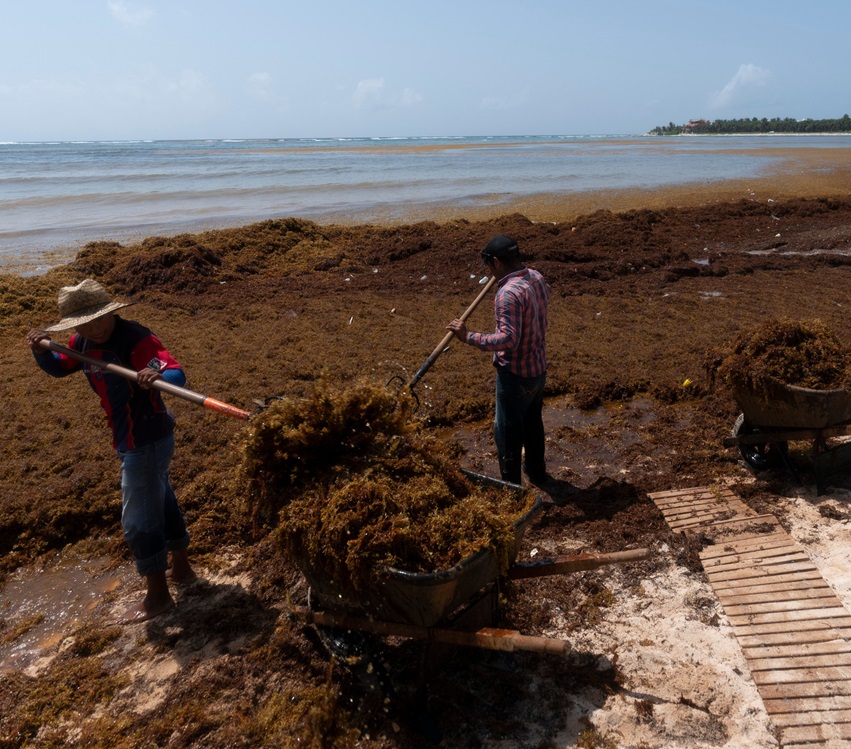

Seaweed in Tulum's Beaches
What you need to know and how to avoid it!
SUMMARY
- Seasonality: May to October, coinciding with humid and rainy months.
- Impact: Rotting seaweed produces hydrogen sulfide gas and attracts animals.
- Avoidance: Plan your trip between November and April for a seaweed-free experience.
- Municipal beaches: Free and open, but may have limited seaweed removal.
- Beach clubs: Offer better seaweed control and additional amenities.
- Recommended beach clubs: Taboo Tulum, Bagatelle, Vagalume, Tantra.
- Stay informed: Check for updates on seaweed conditions and beach cleaning efforts.
If you've come to Tulum and enjoyed the incredible beaches it has to offer, surely you've seen or heard about the seaweed. Sometimes it is only a little spotting on the white beaches and sometimes in voluminous heaps.
This might be an inconvenience in the area, however it is part of the natural ecology of Tulum. Even so, sometimes the odor or quantity can be a lot. Let's see what you can do to have a better experience!

The Seaweed Season in Tulum
The seaweed encountered here is called Sargassum, and its season in Tulum typically spans from May to October, coinciding with the humid and rainy months when temperatures rise and the seaweed reproduces.
During these Tulum seaweed months, the beaches are more likely to have seaweed. To avoid seaweed completely on Tulum's beaches, it’s best to plan your trip between November and April.
When sargassum washes up on the beach, it will rot after some time. The rotting process produces hydrogen sulfide gas, which makes the seaweed smell like rotten eggs and it attracts animals that come to consume it, so it's not risky, completely natural and expected, but also inconvenient.
Best Beaches in Tulum & Seaweed Control
There are a lot of municipal free and open beaches in Tulum, but they only have a lifeguard service and the seaweed control crew can take its time to appear since it is always working at capacity. So, if you want to ensure that once you get to Tulum you can enjoy your beach days, your best option is to book a place in a private beach club.
The government and most establishments along the coast have stepped up their efforts to tackle it, however, the majority of low-budget places do not have the means to clean their beaches daily, since removal is done by hand when possible because heavy front-loaders can damage the beach and harm wildlife such as turtle egg nests.

- Taboo Tulum | They are in the middle of the central beach with a beachclub and restaurant where you can watch live DJs and other music, with a variety of spaces and different sections of the beach. The must go of beachclubs when you want to try all of Tulum.
- Bagatelle | This beach club has the most luxurious Bali beds, and a perfect take on what a beach club experience has to be. In Bagatelle you’ll find French, Mediterranean, and Mexican cuisine and a beachside view.
- Vagalume | Other of the main beach clubs in town, Vagalume has live music and a dancefloor open to the beach where you can wander around the natural landscape, use some of the beach amenities or in case the seaweed is too much that day, the pool.
- Tantra | When you want to relax and unwind, you can enjoy what Tantra Beachclub offers - At its facilities, you will find handmade umbrellas, lounge chairs, VIP cabins, private residences, holistic massages and an internal restaurant using local produce and a variety of techniques that make a menu chosen with care against all dietary needs.
To summarize, there are two options to navigate the seaweed in Tulum
Option 1 | Embrace the Nature & Enjoy Private Beach Clubs
- Visit Tulum anytime- Despite the seaweed, Tulum remains a beautiful destination.
- Opt for private beach clubs- These often have dedicated staff to clear seaweed and provide a more serene experience.
- Maintain an open mind- Seaweed is a natural phenomenon. Embrace it as part of the coastal ecosystem.
Option 2: Plan Your Visit for Seaweed-Free Months
- Travel from November to April- These months typically have minimal seaweed presence.
- Maximize your beach time- Enjoy uninterrupted sunbathing, swimming, and water activities.
Sargassus | Additional information
The seaweed that appears in Tulum is one kind of marine algae called "sargassus" that lives completely in the open sea, in rafts held afloat by little oxygen bags. It gets tangled with another algae and forms rafts that sail around, and when they touch shore they are expelled by the tide.
According to Maine Coast Sea Vegetables "Before about 2011, the relatively small amounts of sargassum washing up on beaches were a normal and even beneficial aspect of coastal ecology.
In 2011, though, researchers began tracking enormous accumulations at sea washing ashore onto African and Caribbean beaches. Scientists speculated that sargassum growth was being accelerated by climate change. According to this hypothesis, changing ocean currents brought about by melting poles and glaciers, combined with increased nutrients from human activities, have helped sargassum reproduce and grow at record speeds."
Even when it is a bothersome part of the natural process of the sea environment that's been exacerbated in later years, it is still beneficial to humans. Not only does the decomposition fill the land and water with nutrients for everything that lives in the area, but also it is useful for construction, biofuel and it is even edible! At least six species are consumed in Korea, Japan, and China, and sold dried, salted, or fresh, and consumed in soups, vegetable dishes, salads, or used in various seasonings. You can find it usually marketed as hijiki (or hiziki).
“Whenever you find yourself on the side of the majority, it is time to pause and reflect.” -Mark Twain.
 HAVE A QUESTION
HAVE A QUESTION

Feeling Lost?
We know the scene inside out. Let's curate your perfect night.
TOOLS
 POPULAR
POPULAR
CONNECT

Check Our Instagram Stories For More

 HAVE A QUESTION
HAVE A QUESTION 





 POPULAR
POPULAR 

 Instagram
Instagram 









